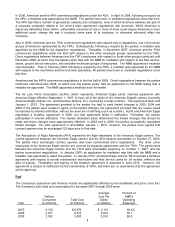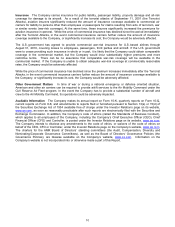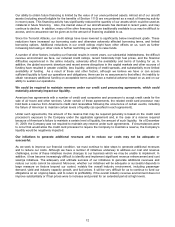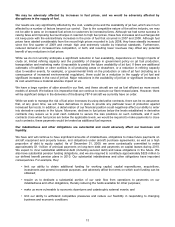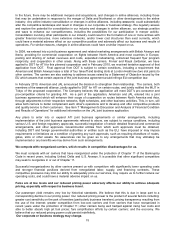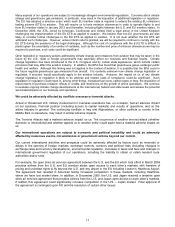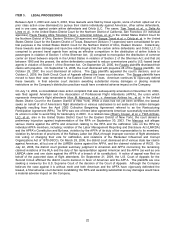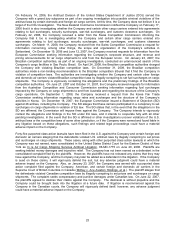American Airlines 2009 Annual Report Download - page 20
Download and view the complete annual report
Please find page 20 of the 2009 American Airlines annual report below. You can navigate through the pages in the report by either clicking on the pages listed below, or by using the keyword search tool below to find specific information within the annual report.
17
Many aspects of our operations are subject to increasingly stringent environmental regulations. Concerns about climate
change and greenhouse gas emissions, in particular, may result in the imposition of additional legislation or regulation.
The EU has adopted a directive under which each EU member state is required to extend the existing EU emissions
trading scheme (ETS) to aviation. This will require us to have emission allowances in order to operate flights to and
from EU member states in January 2012 and thereafter, including flights between the U.S. and EU member states. In
December 2009, the ATA, joined by American, Continental and United, filed a legal action in the United Kingdom
challenging the implementation of the EU ETS as applied to aviation. We believe that non-EU governments are also
likely to consider formal challenges to the EU ETS as applied to aviation. It is not clear whether the EU ETS will
withstand such challenges. However, unless interim relief is granted, we will be required to continue to comply with the
EU ETS during the pendency of the legal challenges. Although the cost of compliance with the EU ETS is difficult to
predict given the uncertainty of a number of variables, such as the number and price of emission allowances we may be
required to purchase, such costs could be significant.
Other legislative or regulatory actions addressing climate change and emissions from aviation that may be taken in the
future by the U.S., state or foreign governments may adversely affect our business and financial results. Climate
change legislation has been introduced in the U.S. Congress and by certain state legislatures, which include certain
provisions that may affect the aviation industry. In addition, the EPA has found that greenhouse gases endanger public
health and welfare. Although this finding was not applied in the context of aviation, it is possible that the EPA could in
the future regulate greenhouse gas emissions from aircraft. It is currently unknown how climate change legislation or
regulation, if enacted, would specifically apply to the aviation industry. However, the impact on us of any climate
change legislation or regulation is likely to be adverse and related costs of compliance could be significant. Such
legislation or regulation could result in, among other things, increased fuel costs, carbon taxes or fees, the imposition of
requirements to purchase emission offsets or credits, and restrictions on the growth of airline operations. We continue
to evaluate ongoing climate change developments at the international, federal and state levels and assess the potential
associated impacts on our business and operations.
We could be adversely affected by conflicts overseas or terrorist attacks.
Actual or threatened U.S. military involvement in overseas operations has, on occasion, had an adverse impact
on our business, financial position (including access to capital markets) and results of operations, and on the
airline industry in general. The continuing conflicts in Iraq and Afghanistan, or other conflicts or events in the
Middle East or elsewhere, may result in similar adverse impacts.
The Terrorist Attacks had a material adverse impact on us. The occurrence of another terrorist attack (whether
domestic or international and whether against us or another entity) could again have a material adverse impact on
us.
Our international operations are subject to economic and political instability and could be adversely
affected by numerous events, circumstances or government actions beyond our control.
Our current international activities and prospects could be adversely affected by factors such as reversals or
delays in the opening of foreign markets, exchange controls, currency and political risks (including changes in
exchange rates and currency devaluations), environmental regulation, increases in taxes and fees and changes in
international government regulation of our operations, including the inability to obtain or retain needed route
authorities and/or slots.
For example, the open skies air services agreement between the U.S. and the EU which took effect in March 2008
provides airlines from the U.S. and EU member states open access to each other’s markets, with freedom of
pricing and unlimited rights to fly beyond the U.S. and any airport in the EU including London’s Heathrow Airport.
The agreement has resulted in American facing increased competition in these markets, including Heathrow,
where we have lost market share. In addition, in December 2009, the U.S. and Japan reached a tentative open
skies air services agreement that provides airlines from the U.S. and Japan open access to each other’s markets.
If ratified, this agreement could significantly increase competition in the U.S. – Japan market. Final approval of
the agreement is contingent upon ATI and the resolution of certain other issues.



